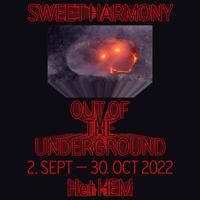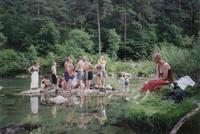Sweet Harmony: Out of the Underground
From 2 September 19h to 30 October 2022, Het HEM presents Sweet Harmony: Out of the Underground – the third edition of a series of exhibitions that reflect on 40 years of rave culture from an artistic point of view.
After previous editions in London and Manchester, the third edition of Sweet Harmony takes place in the most suitable space in Het HEM: the 200m-long former shooting range in the basement of the building. Raw and dark with multigenerational graffiti on its concrete walls, the tunnel’s post-industrial architecture will feel like familiar territory to ravers old and new.
Rave has been a breeding ground for creative expression since its inception in the US (Chicago and Detroit), the UK, the Balearics and continental Europe. Sweet Harmony shows works of artists who came from rave culture or are inspired by it in their practice. Their artistic expressions touch upon themes such as the spiritual and mythical aspects of rave; rave as a space for queer play and resistance; and exposes how rave culture has emerged in various cities worldwide at the same time.
The nightclubs Waakzaamheid in Koog aan de Zaan, Parkzicht in Rotterdam, and the RoXY in Amsterdam were places of prominence where manifestations of the Dutch rave and house culture in the late eighties and early nineties originated.
Sweet Harmony outlines the broad international context in which Dutch rave culture is embedded. It gives new meaning to local, seemingly self-contained expressions of mass youth culture and its impact on contemporary art and culture on a global scale.
For Sweet Harmony, guest curators Inez Giele de Jong and Joost van Bellen, former programmers of the Club RoXY, have compiled an ode to the art collection of this illustrious Amsterdam nightspot, which put culture, art and music movements such as house, easy tune and hip-hop on the map in the Netherlands.
Under the name R.A.R.O.X.Y. 'Reminiscing the Artwork of the Radical outlet for the Xenomaniac in You', this mini-exhibition emphasises the presence of art and performance with the belief that it has been the inspiration for spectacle esthetics at festivals as we know them today.
Participating artists of Sweet Harmony include Harvey Ross Ball, Aukje Dekker & Gerald van der Kaap, Meeus van Dis, Franklin, Thomas van Linge, Michele Rizzo, Sarah Schönfeld, Alyson Sillon, Ari Versluis, Juha van 't Zelfde, Spyros Rennt, Mark Leckey, Vinca Petersen
The R.A.R.O.X.Y. Room includes artworks from artists Paul Blanca, Leigh Bowery, Cleo Campert, Jean-Paul Commandeur, Erik Fens, Peter Giele, Pieter Bijwaard, Harry Heyink, René Habermacher, Jurriaan van Hall, Gerald van der Kaap, Inez van Lamsweerde & Vinoodh Matadin, Seymour Likely, Siert Dallinga, Maxim Meekes, Erwin Olaf, Ruud van der Peijl, Walter Russ, Niels Schumm & Nepco, Gebr. Silvestri, Aam Solleveld, Jan Verburg, Guus van der Werf and more.
Accessibility Disclaimer:
Sweet Harmony takes place in our underground shooting range, which regretfully is only accessible through stairs. People in a wheelchair or with other mobility aids, please contact us prior to your visit so that we can assess how we can facilitate your visit to this exhibition.
The exhibition also includes very dark sections, fast flickering and loud sounds.

